The podcast episode today is all about a Dysbiosis Diet Plan and The GutSMART Protocol with Dr. Pedre).
Our special guest, Dr. Pedre, specializes in all things gut health.
He is a functional medicine certified practitioner and has recently published the book “GutSMART Protocol.”
I am so excited to have him on the podcast for the second time to share all about SIBO, leaky gut, inflammation, and his new book.
This is an episode you don’t want to miss.
Subscribe Today:
Apple Podcasts | Google Podcasts | Spotify | iHeart Radio | RSS
Dysbiosis Diet Plan (The Gutsmart Protocol with Dr. Pedre)
Click HERE to save this post for later.
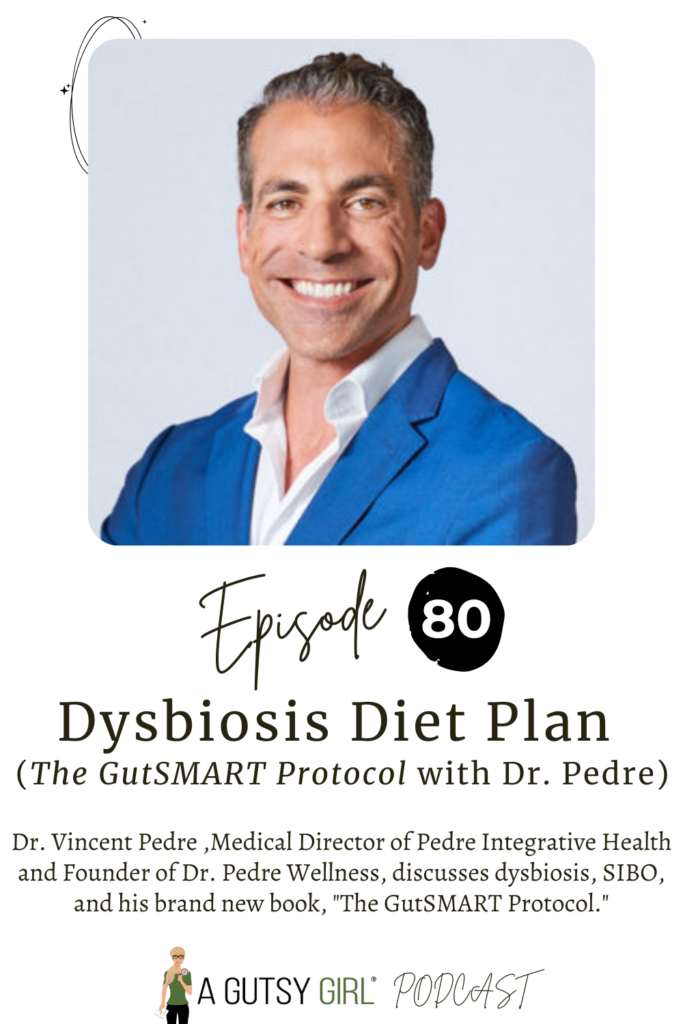
Resources
- Follow Dr. Pedre on Instagram
- Get The GutSMART Protocol book
- Check out Dr. Pedre’s website
- Episode 8 with Dr. Pedre
- Fight or Flight
- A Gutsy Girl’s journal
Don’t Miss These Thoughts
- What does it mean to have a gut dysbiosis?
- What is the difference between gut-centric and gut-related symptoms?
- The difference between a bacterial overgrowth and dysbiosis.
- How does Dr. Pedre describe leaky gut in the most simplistic terms and what does it have to do with our overall health?
- What is in The GutSMART Protocol?
- The book has a lot of recipes, so what the heck to eat with dysbiosis? What do you think is the best approach for healing various gut issues?
- Gut-friendly recipes that everyone can enjoy.
What is Gut Dysbiosis?
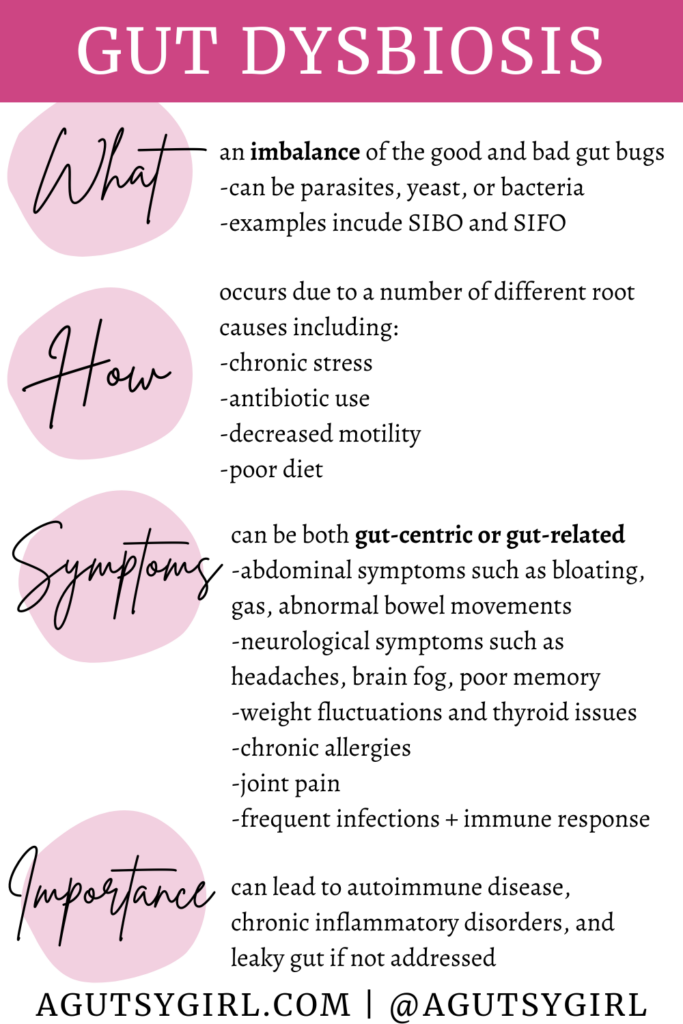
Dr. Pedre defines gut dysbiosis as “an imbalance between the good and bad gut bugs.” This occurs when the bad pathogens in our gut outweigh the good or become “overgrown.”
Although we commonly think of this happening with bacteria, it can also occur with an overgrowth of parasites, yeasts, worms, bacteria, and viruses. Any microbe in our gut can become overgrown and throw off the gut ecosystem as a whole.
In theory, it may not sound like a huge deal, but the gut truly is the center of our health. Failure to properly address dysbiosis can lead to HUGE issues down the line such as immune system dysregulation, hormonal imbalances, and chronic inflammatory disorders.
Dr. Pedre explains gut dysbiosis as “the first domino that starts a chain reaction.” Without getting the gut back into balance, you run the risk of developing these serious issues down the line. The best thing you can do is address the dysbiosis and work backwards, healing your entire body along the way.
A Healthy Gut Ecosystem
Our guts are home to over 10^14 microorganisms consisting of yeast, bacteria, and other microbes. This may sound gross in theory, but in the right balance, all of these microorganisms work together to help digest food and create neurotransmitters for your nervous system.
Beneficial bacteria and yeasts help to break down nutrients into their smallest parts so that they can be absorbed, so do not be alarmed by them! They are entirely necessary for the health of your entire digestive tract and body.
A healthy gut helps to:
- absorb nutrients from your food
- participate in the release and creation of hormones
- encourage healthy immune response
- create neurotransmitters and partake in mood regulation
- increase serotonin and encourage mental health
With all of the roles the gut microbiome plays, it is no wonder that an imbalance can lead to so many issues.
The gut is home to so many processes of the body- from immune system regulation to inflammatory control.
Prioritizing your gut health truly leads to so many health benefits and stabilizes the well-being of your entire body.
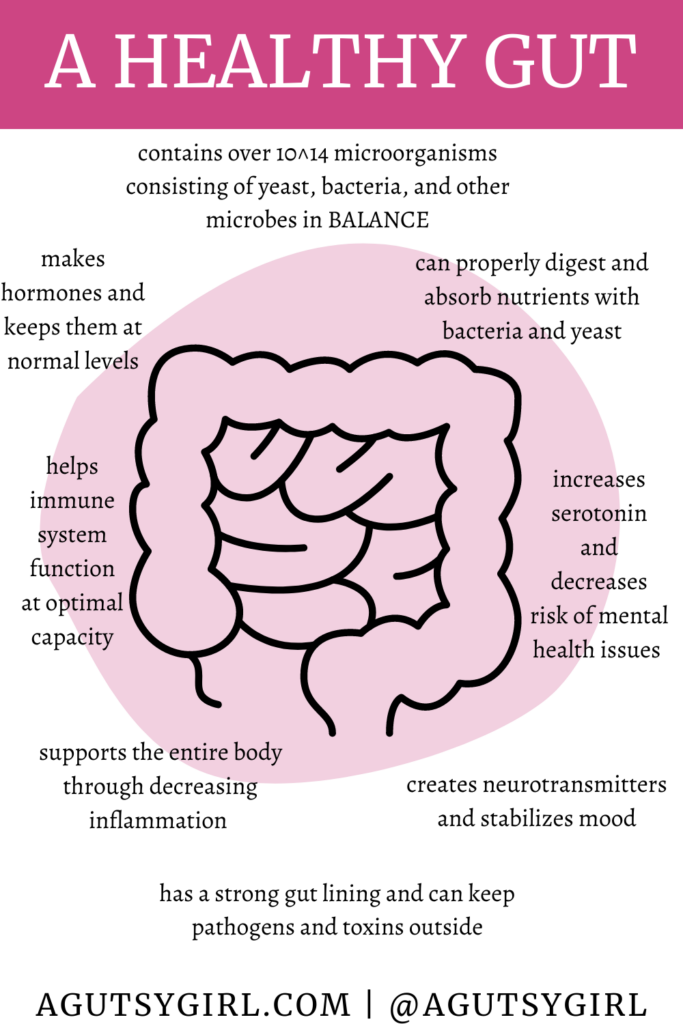
Symptoms of Dysbiosis
While some symptoms point to obvious gut issues, others are less obvious and can easily be mistaken for something else.
Gut-centric symptoms, or gastrointestinal symptoms, are the easiest way to pinpoint some sort of dysbiosis. Most of you most likely fall into these category, as you struggle with some sort of gut dysfunction.
Symptoms of gut dysbiosis include:
- abdominal pain
- bloating
- gas
- constipation
- diarrhea
- reflux
- symptoms associated with irritable bowel syndrome
These are extremely easy to trace back to the gut because they are “digestive issues,” so oftentimes dysbiosis can easily be addressed and fixed.
The harder part comes from determining gut-related symptoms.
These are a group of symptoms that originate from gut dysfunction, but are often attributed to some other cause or disease.
Doctors often provide “quick fixes” to these issues, but the underlying cause is never addressed.
Some of these symptoms include:
- allergies
- mental fog
- headaches
- trouble remembering things
- respiratory infections
- thyroid issues
- inability to lose weight (and other signs of insulin resistance)
- sudden weight gain
- white coating at the back of the throat
- joint pain
As you can see, most of these symptoms are fairly vague and non-specific.
It can be easy to write them off as other issues, but if they keep occurring, it could be a cause of gut dysbiosis.
Most allopathic doctors (or traditional Western doctors) are not fully realizing the scope of the gut in how it relates to the rest of the body. If your gut is not functioning fully, your body will not be either.
Advocating for Yourself
This is part of the reason that advocating for yourself and knowing your body is so important. If your issues sound like they could be gut-related, then mention your concerns to your healthcare providers.
You could be saving yourself from other issues down the road and a progression of these uncomfortable symptoms.
Remember- you know your body better than anyone else. If something is wrong, do not be afraid to speak up for yourself.
Bacterial Overgrowth vs. Dysbiosis
There can often be some confusion between different aspects of dysbiosis, so Dr. Pedre clarified some of the key distinctions.
SIBO, or small intestinal bacterial overgrowth, is something I talk about all of the time on this website. This is an issue that I personally struggled with, and I know a lot of you do as well.
SIBO is actually an example of dysbiosis, or imbalance or organisms in the gut. It is a dysbiosis of gut bacteria, with the bad bacteria growing out of control in the small intestine and causing issues such as bloating, constipation, or diarrhea.
These symptoms are usually seen 20-60 minutes after eating and have some tell-tale distinctions between different types of dysbiosis.
Just because you have dysbiosis does not mean that you have SIBO. Dysbiosis can be caused by an imbalance of so many other organisms and is not just limited to bacteria.
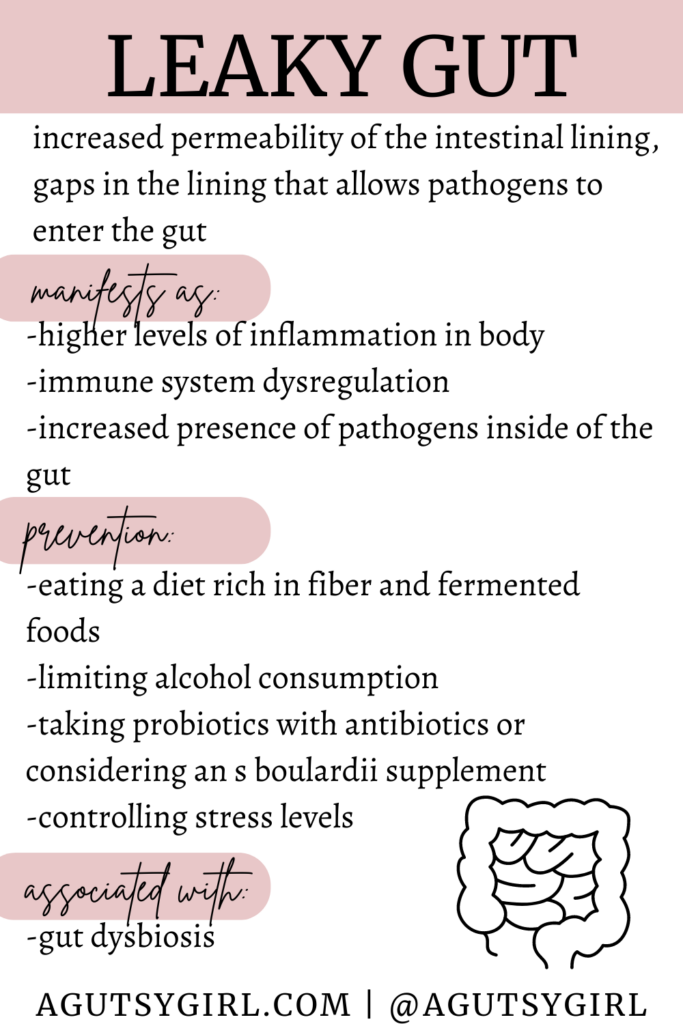
Leaky Gut
Leaky gut is another aspect of dysbiosis that is often poorly understood.
It is an issue with the LINING of the gut, while dysbiosis is an issue with the ORGANISMS INSIDE of the gut.
It is often referred to as “increased intestinal permeability,” meaning that the intestinal lining is letting more substances through.
This occurs when the tight junctions between intestinal cells are disrupted, resulting in a looser lining.
Dysbiosis often leads to leaky gut, as good bacteria helps to support the mucosal lining and layers of the intestines.
When the balance of bacteria is thrown out of wack, the body has a hard time preserving the mucosal lining of the intestines.
Dr. Pedre compares leaky gut to a coffee filter. When the gut lining is “not leaky,” it works like a regular coffee filter, allowing the coffee (nutrients) to come into the coffee (gut). You want your coffee to be purely filtered and not contain any coffee grounds.
When your gut is leaky, it more closely resembles a coffee filter with holes poked into it. This allows a lot of pathogens and toxins to enter the gut, instead of staying outside.
This can include bacteria, bacterial by-products, endotoxins, and other pathogens.
The arrival of these “bad guys” into the gut can trigger high inflammation and immune responses. These can activate inflammatory pathways all throughout the body and lead to issues such as chronic pain, headaches, and other non-specific symptoms.
You also run the risk of developing autoimmune diseases in the future.
Leaky Gut Causes
Leaky gut is usually caused by dysbiosis, but it also has several other root causes. You will find a lot of overlap in causes between dysbiosis and leaky gut, so keep that in mind as well.
Here are some of the most common root causes:
- antibiotics- extremely helpful but can sometimes be used in excess
- over the counter pain medications- alleve, advil, and other pain medications when used excessively
- alcohol- very damaging to the lining of your small and large intestine
- birth control pills- hormonal changes and increased permeability
- poor diet- traditional Western diet, often high in sugar and low in fruits and vegetables
- chronic stress
I do understand that sometimes you really do need antibiotics, and this is not me making a case against them.
If you need to take antibiotics and/or other medications, you should 100% take them!
Just know that they may have some long-term impacts on your gut that you need to be aware of.
Dr. Pedre does mention a couple of preventative measures you can take with antibiotics in order to decrease the risk of leaky gut.
Consider an S Boulardii supplement
S boulardii is a yeast based probiotic that can help to protect the gut lining and maintain gut integrity. This can be particularly useful when taking an antibiotic, as the yeast will not interfere with the antibiotic function.
Add in probiotic supplements
It can also be helpful to take a high potency probiotic with antibiotics, in order to ensure that your gut flora stays intact. This can prevent dysbiosis from occurring and resulting in leaky gut.
With probiotics, make sure to space them out from your antibiotics, otherwise they will counteract one another.
Separate them by several hours for optimal results.

The ‘A Gutsy Girl’ probiotic of choice + the only one we truly promote and recommend.
Gut Diversity and The Microbiome Diet
One key point Dr. Pedre mentioned is the direct connection between diversity of the gut microbiome and chronic inflammation in the body.
Studies show that the more diverse your gut microbiome is, the lower your probability of developing inflammatory disease will be.
You can actually use diet as a way to improve microbial diversity and decrease inflammation throughout the body, as well as preventing leaky gut.
Here are two of the best things you can add to your diet for this purpose:
Fermented foods
Fermented foods are a GREAT way to improve microbial diversity.
These include foods such as yogurt, kefir, and sauerkraut. Research has found fermented foods to lower the levels of at least 19 different inflammatory markers in the body, which is absolutely insane.
While I know some of you probably don’t do super well with fermented foods, I 100% recommend them if you can tolerate even a little bit. Even adding a bit of dairy free yogurt into your daily routine can make a difference for the health of your gastrointestinal tract.
Fiber-rich food
Fiber rich food has also been shown to help encourage a healthy immune system.
This includes foods high in fiber such as oats, grains, beans, and apples. By including these into your diet you can help support your immune system and decrease inflammatory response in your body.
An added benefit of both of these food groups includes an improvement in anxiety and mental state.
By altering the diversity of your gut, you can also help to support your all-around mental health.
The GutSMART Protocol
Now of course we have to talk a bit about Dr. Pedre’s new book, The GutSMART Protocol.
I am so excited about this book and the impact it is going to have on the gut-healing community!
It includes so many features and helps cater the right treatment to each “gut type,” which is found by taking a quiz in the book.
Other features include:
- information on gut dysbiosis, symptoms, and the microbiome
- gut smart quiz for identifying gut type
- diets for each gut type to help heal
- recipes catered to your specific gut microbiota
- exercises to improve gut-brain connection such as meditation and breath work
One of my favorite features of the book is Dr. Pedre’s own meditation called the Gut Love Meditation.
This is built on mending your relationship with your body and sending love to the gut and gut microbiome. This is a game-changer for anyone going through their own gut-healing journey, as mindset is one of the biggest roadblocks to healing.
You can purchase the book on Amazon HERE, and I definitely encourage you to check it out!
Good Gut Health Recipes
The recipes Dr. Pedre includes in his book are specifically designed for different gut types and individuals.
Some of the recipes include gut-healing foods such as:
- bone broth recipes- great for soothing the gut lining and repairing leaky gut
- gut happy granola
- smoothies- additions such as blue spirulina for gut boosting benefits
- turmeric cauliflower
The recipes include a lot of spices, which are fabulous for any sort of gut-healing.
Consuming spices such as turmeric, ginger, and fennel on a regular basis can help to reduce inflammation and promote a healthy gut microbiome.
There are so many gut-healing foods, and diet is truly a great way to help jumpstart your digestive health.
By making dietary changes you can encourage not only a healthy gut microbiome, but also the health of your entire body.
Research Findings
Instead of asking Dr. Pedre his three gut-healing convictions, I thought we could pick his brain a bit more. I asked him to share some research he felt was up and coming in the gut space.
He mentioned how a lot of recent research is on the importance of the nervous system for gut-healing. It has been scientifically proven that breath work is one of the best avenues for controlling your nervous system and getting out of constant “fight or flight” mode.
By engaging in these activities you can shift your body to a parasympathetic state and encourage proper healing to occur.
More from A Gutsy Girl
Want to learn even more about the gut and ways to heal it?
The best way to learn all the secrets is via my signature book, A Gutsy Girl’s Bible: a 21-day approach to healing the gut. Grab your copy on Amazon HERE.
- Welcome to A Gutsy Girl Podcast
- Hang out on Instagram
- BFF’s on YouTube
- Free resource: The Master Gutsy Spreadsheet
- Rated-G Email Club
Wrap-Up
As always, a huge goal for this show is to connect with even more people. Feel free to send an email to our team at podcast@agutsygirl.com. We want to hear questions, comments, show ideas, etc.
Did you enjoy this episode? Please drop a comment below or leave a review on Apple Podcasts.
Bio: Dr. Vincent Pedre
Dr. Vincent Pedre is the Medical Director of Pedre Integrative Health and Founder of Dr. PedreWellness, CEO/Founder of Happy Gut Life LLC, has worked as a nutraceutical consultant and spokesperson for NatureMD, and is a Functional Medicine-Certified Practitioner with a concierge practice in New York City since 2004.
He believes the gut is the gateway to excellent wellness. His newest book, The GutSMART Protocol — featuring a 14-day personalized gut-healing plan based on the GutSMART Quiz — is the culmination of years of research and clinical experience as a functional gut health expert.
If you liked this post on the Dysbiosis Diet Plan you might also enjoy:
Xox,
SKH
🤰 bloating be gone! weight loss through optimal gut health for women
💃ʜᴇᴀʟ ʏᴏᴜʀ ɢᴜᴛ. ʜᴇᴀʟ ʏᴏᴜʀ ʟɪfe.
🫶🏻 founder gutbyome.com



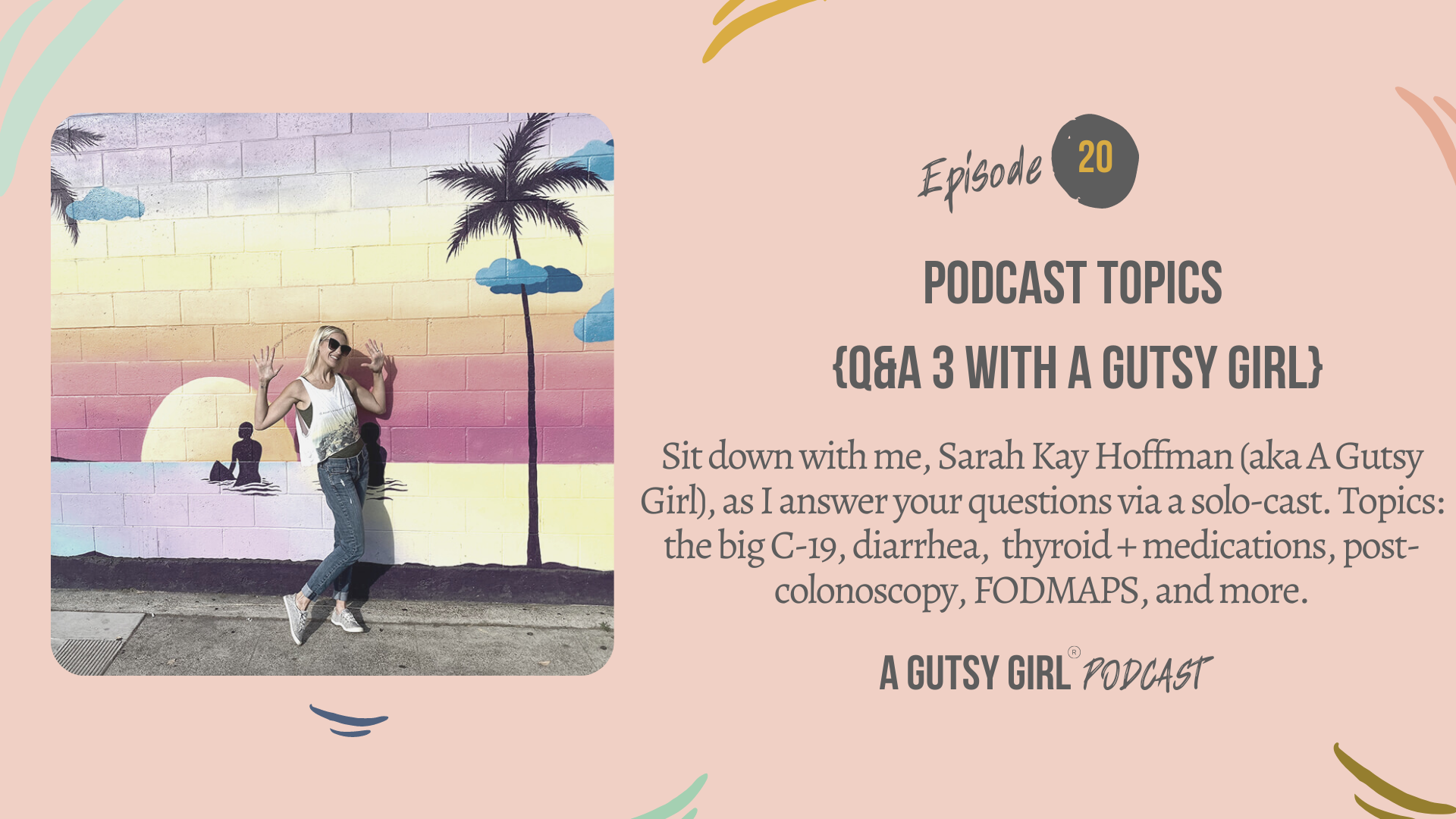

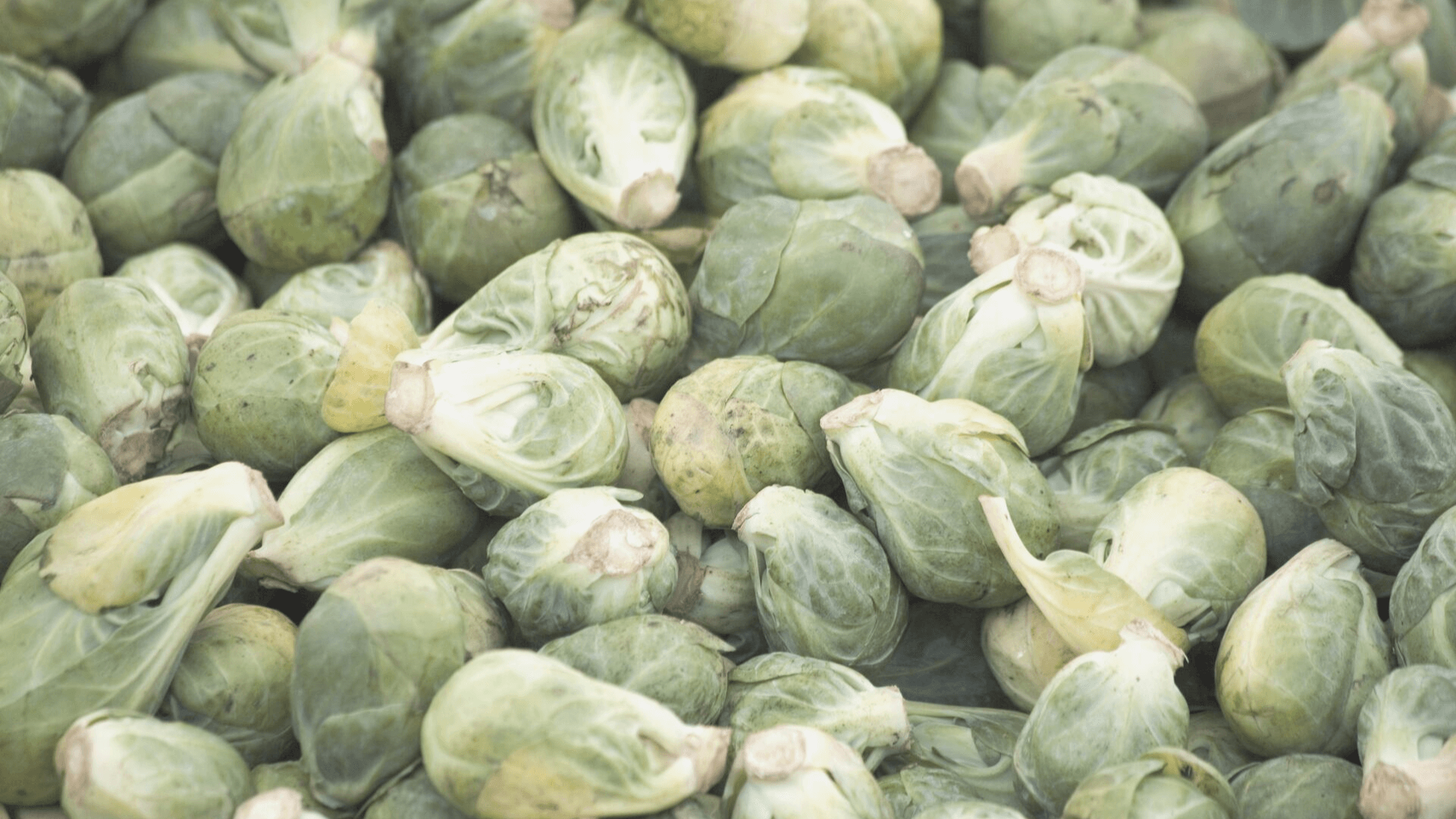
![What is Ayurveda – [The Ultimate Beginner’s Guide]](https://agutsygirl.com/wp-content/uploads/2024/10/ayurveda-featured.png)